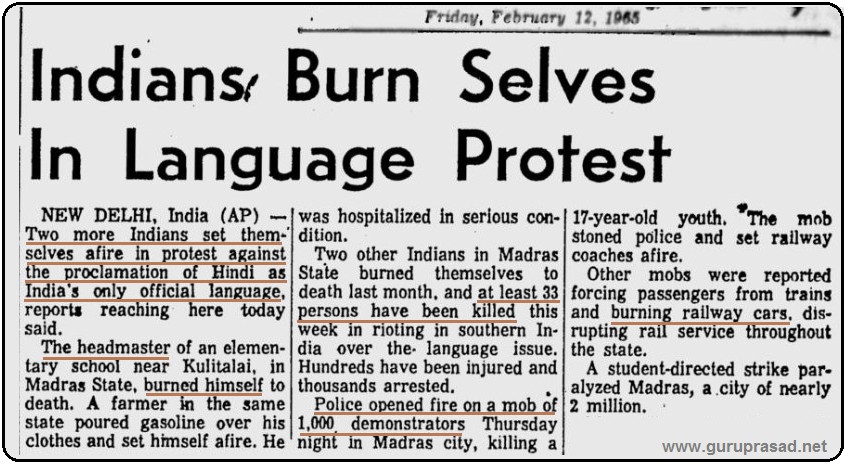I read an article here that talked of twitter being up in arms over the Union government’s attempts to impose Hindi. some Twitterati felt that Modi, by delivering most of his speeches in Hindi was deliberately disrespecting the non-Hindi speaking population of the country. The article also quoted some unknown personages who claimed that Hindi was understood by around a quarter of the country’s population (the reality is around 40% of Indians understand Hindi) and Modi was deliberately disregarding that by rambling on in Hindi. Why is it that even after 7 decades of independence and mostly peaceful co-existence among various linguistic groups, anti-Hindi (-ism) continues to be a popular cause, whereas we have accepted, English, a foreign language, with open arms?
A historical perspective:
It has mostly been the South that has been at the forefront of anti-Hindi agitation. In late 1930s, Madras state erupted in protests, when the Congress government made Hindi a compulsory subject. The same issue re-surfaced soon after independence. Periyar and his Dravidar Kazhgam were at the forefront of these agitations. At the time of framing of India’s constitution, the constituent assembly was deeply divided between those who wanted Hindi as a national language and those who opposed it. As a compromise, it was decided to do away with the nomenclature of “national language”. It was decided that Hindi along with English and several regional languages was to be the official language. It was also decided that the government would endeavour to do away with the usage of English in 15 years’ time, by when, Hindi would become the sole language of correspondence within between the states and the Union. When the time came for implementing this decision, the South, once again was engulfed in anti-Hindi agitations. Several protesters lost their lives and the government vacillated before Indira Gandhi introduced a constitutional amendment establishing the bi-linguism that has persisted till date.
But why hate Hindi?
India has several language families that thrive in the country. The most prominent ones are Indo-Aryan (Hindi,Urdu, Marathi, Punjabi,Gujarati, Bengali, Assamese etc.), Dravidian (Tamil, Malayalam, Kannada and Telugu), Tibeto-Burman (spoken mostly in the North East and Ladakh) and Austroasiatic (Munda, Khasi etc.). Indo-Aryan languages basically from Sanskrit and Prakrit (though Islamic invasions brought in many loanwords from Arabic and Persian and the arrival of Europeans enriched these languages with European words). Dravidian languages stem from Old Tamil, though Sanskrit words were freely borrowed (and local words freely exported into Sanskrit), as were words from European and other Asian languages. Over a period spanning several millennia, Sanskritic and Dravidian languages influenced each other, along with the influence of other languages, resulting in the languages that we know today.
The hatred of Hindi in the South started with the anti-Brahmin Self Respect Movement. Periyar agitated against the overwhelming influence wielded by the handful Brahmin minority in the political, social and economic spheres. Periyar, along with his other Justice Party colleagues sought to build a Tamil identity by denying the Brahmins the power they had formerly wielded. Given the importance of Sanskrit in their rites and rituals, Brahmins were an easy target for this Nationalist movement of sorts. Over a period of time, Hindi came to be equated with the much detested Brahmin population of this region, who were viewed as agents of the North. Tamil Nationalists claimed a unique history for their language and flatly denied any association between Tamil and Sanskrit. The issue of Hindi language, thus, became a political issue and continues to be so even today. Such virulent anti-Hindi sentiments, were however, not witnessed in any other state in India.
A National language:
Given that the issue of language has been heavily politicized, it is highly unlikely that we would ever be able to have a dispassionate and logical debate on this issue. It is unfortunate that in a linguistically rich country such as India, we need a foreign language (English) as a medium of communication among people. Obviously, in a globalized world such as ours, knowing English has its benefits, but it need not necessarily be a replacement for our own languages. Almost all specialists believe that a child learns best when taught in his mother tongue. Yet, we continue to force our children to learn Shakespeare and Milton by the rote, while glossing over Kalidasa and Thiruvalluvar. Instead of building a system that encourages a Punjabi to learn Tamil and vice versa, we choose to force English down everyone’s throat. And what is the result of this? Our languages are dying, bit by bit. Unlike English, which is flourishing with the introduction of new loanwords and phrases, our languages are becoming stultified, much like Sanskrit, which after millennia of efflorescence, is today a dead and buried language.
Israel revived Hebrew which was then a dead language (much like Sanskrit today) and today it is a flourishing national language there. We can also look at evolving a common national language. While Hindi is an easy choice, but given the prevalence of anti-Hindi sentiments, it will be a difficult step. In fact, Hindi, Tamil,Bengali, Telugu, Odia and others need not be the national language. A new national language that takes the best features of diverse Indian languages can also be explored as an option. Like Esperanto tried to be the language of the world, we could have a “Bharati” as a common language of India. Sanskrit can be another choice, given its pan India presence, but given the politics around Sanskrit, it is highly unlikely if it would ever be accepted.
In the words of Michael Madhusudan Dutta, “If there be any one among us anxious to leave a name behind him, and not pass away into oblivion like a brute, let him devote himself to his mother-tongue. That is his legitimate sphere his proper element”.
It is time to give Indians a common Indian language!

